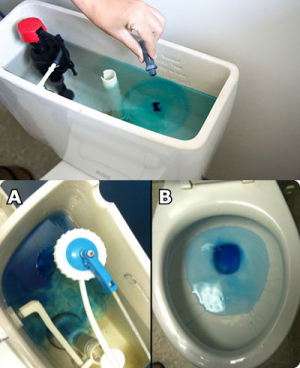
Leaking toilets are the number one source of wasted water in the home. A leaky toilet tank wastes between 300 gallons (slow leak) and 60,000 gallons (running toilet) per month. To safeguard against this problem, it is highly recommended that you perform this test at least twice a year. Catching a toilet leak at its earliest stage can save a lot of water from being wasted as well as money on your water bill each month. To detect a slow leak watch the How to Detect a Leaky Toilet video or follow these steps:
- Put 10-15 drops of food coloring or a dye tablet in the toilet tank.
- Wait 30 minutes without flushing.
- After 30 minutes, if the water in the bowl turns color, your toilet tank is leaking.
- Replace the parts inside your toilet tank. Repair kits are inexpensive and are available at most hardware and home improvement stores.
Flapper Valve Leaks
The most common reason for a leaking toilet is one that has an improperly working or sealing flapper. The flapper is the rubber valve in the bottom of the tank that lifts up when the toilet is flushed. If the flapper is worn or cracked, it allows water to continuously flow from the tank into the toilet bowl without flushing.
Flush Handle Problems
If the handle needs to be jiggled to keep the toilet from running, the flush level bar and chain (or the handle itself) may be sticking. Adjust the nut that secures it in the toilet tank. If that does not work, the handle may have to be replaced.
Overflow Tube Leaks
Ideally the water level should be set so that it is about even with the fill line on the back of the toilet tank (approximately ½ inch below the overflow tube). If the water is too high in the toilet tank and is spilling into the overflow tube, the water level can be adjusted by turning the adjustment screw or by very gently bending the float arm down so that the water shuts off at a level below the overflow tube.

